If you’re a Pre-9/11 Veteran, the old, green, issue jungle boot holds a special place in your heart. After over 12 years at war, the Army not only abandoned the design that served us for almost 40 years but seems to have forgotten it ever issued them.
Several commercially developed jungle boots have appeared over the years in including designs from the new defunct OTB, 5.11 Tactical, Oakley LSA Terrain and Water Boots and the Rocky design seen below. I’ve also seen a new design from Bates called the Recondo that is very promising.
Just earlier this year, the Defense Logistics Agency even issued an NSN for a “Fast Drying Boot” to Garmont for the T8 even though it isn’t Berry Compliant because there wasn’t anything else available in the stock system.
Now, based on the “Pacific Pivot” and the resurgence of the Jungle School (in Hawaii), the Army’s PEO Soldier is finally heeding calls from operational forces over the last few years for “Hot Weather Jungle Combat Boots”. About a month ago, COL Robert Mortlock, PEO Soldier’s PM for Soldier Protection and Individual Equipment began to socialize his office’s intent to seek out a new boot. Initially, it sounded as if the boot would be evaluated under the Army’s resurrected Soldier Enhancement Program with commercial solutions cherry picked for the requirement. At the time, it sounded as if only two boots would be looked at and one of those had already failed an assessment by the US Army Special Operations Command. COL Mortlock’s public comments weren’t very encouraging, as they sounded as if the Army had just newly discovered the concept of Direct Molded Sole technology. Mortlock referred to them as “direct attach outsoles” in an Army press release but I don’t think he actually knows what that is, considering he discussed a glued sole in his description. Glue comes apart in a Hot Wet environment and you’re left with pieces of boots. So that SSD readers know, Direct Molded Soles, or “Vulcanized Rubber” soles aren’t glued but rather hot molded into place and were used is the jungle boot as well as the leather leg boot you were issued during Basic training up into the 1990s. Below is a 60-70s model. Later issued leather combat boots swapped out the tread pattern from the chevron seen here, added a padded collar and speed lacing.
They haven’t discovered anything new here. The technology to produce this style of boot sole was developed by a division of Wellco named Ro-Search almost 60 years ago. Unfortunately, almost no one aside from Altama and Wellco still have the machinery to do this because Ro-Search leased, rather than sold, the machines and molds to the various boot manufacturers who supplied the military. When requirements were changed to include more comfortable mid-soles and construction techniques, the machinery was returned to its owners. Once the jungle and desert boots were dropped, the capability was as well.
However, the Army has finally done it right and actually issued an RFI. This Sources Sought Notice allows industry to put their best foot forward and tell the Army how it can fulfill this jungle boot requirement. Hopefully, this will result in an improved requirement when it is actually released.
According to the document:
“The hot weather jungle combat boots must be capable of meeting critical technical requirements, as follows:
1) Durable enough to last 12 months of wear in jungle environments where high humidity and repeated submersion in water are expected;
2) Quick drying and highly breathable, to allow for heat and moisture to exit the boot when worn;
3) Drainage which allows for evacuation of water from the boot while walking;
4) Light weight construction (under 2lbs/boot) with materials that resist water absorption ;
5) A Pronounced heel to allow for improved grip when walking down loose, muddy declines;
6) Tread/Lug pattern that easily sheds mud and debris while walking;
7) Outsoles that provide propulsion and superior traction while allowing for braking and stability moving both up and down wet, muddy slopes;
8) Able to keep mud, sediment, and debris out of boot while maneuvering through water and deep mud;
9) Designed to reduce pressure points and discomfort during descents on uneven, rugged terrain; and
10) Provide for quick break-in.”
The list is fairly broad which is good. But, a few points. We don’t seem to learn lessons very well which will become clear as you read this. Lessons learned in combat during past wars have been forgotten.
The boot cannot have any padding or linings. In the early 90s, Natick added a padded collar to the jungle boot and changed the color to black. The padding would eventually absorb water if you spent any time in a tropical environment. The black color was for uniformity more than camouflage. At least the leather remained smooth, full grain out leather. The current use of rough out leather can be problematic for use in hot-wet environments. That’s a lesson we learned in the Pacific during WWII. Another concern is that companies are going to want to add some form of cushioned midsole for comfort. Please don’t. It will absorb water. Speaking of midsoles, I see no requirement for a counter to ‘punji stakes’. This form of booby trap is a staple of jungle warfare. We learned this lesson in Viet Nam.
Instead of a midsole, the Army issued a Saran mesh insole insert with the jungle boot that provided cushion and helped keep the Soldier’s foot from directly sitting on the footbed in order to help keep the feet dry and increase ventilation. This is absolutely critical in the jungle. Finally, while the requirement is great concerning the capability of the sole, thus far, no one has shown superior performance to the Panama sole created during the Viet Nam specifically to improve traction and shed the mud that builds up in more traditional lug patterns. I for one, am hoping that Altama will offer up their traditional 1960s issue Green Jungle Boot with Panama tread to see how it performs against newer designs.
I’m glad to see that SEP has been reenergized and I’m also happy to see that the Army is seriously looking at jungle equipment. But, I suggest they crack the books and look at what worked in the past and see what might be readopted or adapted.


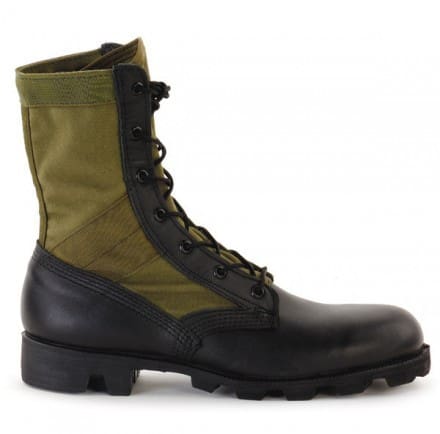
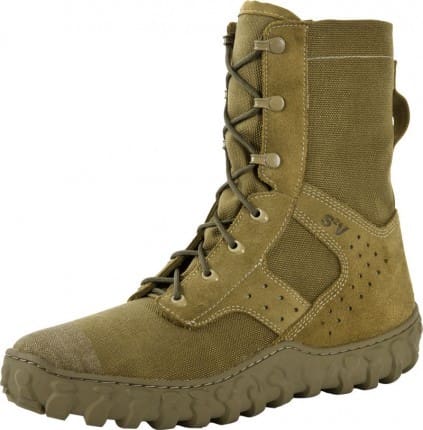
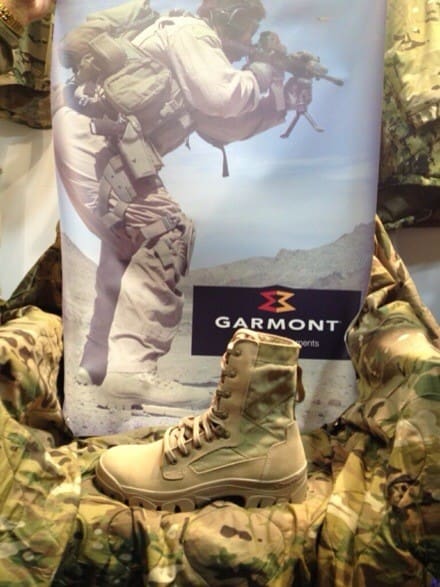
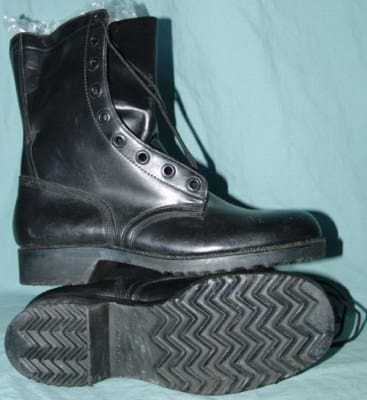
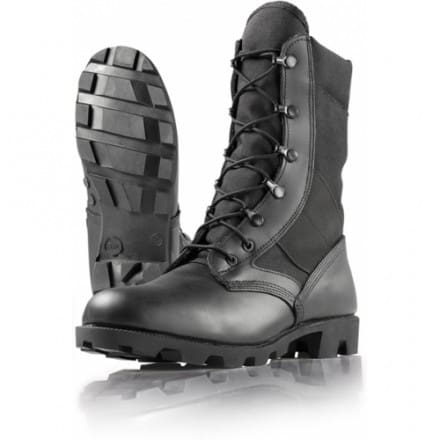
Interestingly, i’ve worn some of those horrible black boots they used to issue in the Australian Army in the lusher parts up north, probably similar in construction to the ones mentioned above and they were, in my experience, absolute shit.
Call me a snob, but I refuse to wear anything out bush that isn’t welted now, with a personal favourite being Crossfire’s Peacekeeper which, incidentally, are made in the USA.
If you wore a pair of issue jungle boots with DMS sole, the sole didn’t come off, they just don’t do that.
Welted construction is trouble, particularly in the jungle. I know it looks cool but that cord is going to let you down and you’ll have a sole flapping about. One of the reasons that you can still get welted construction in the states is that the machinery was designed 150 years ago. Oddly enough, there is little state of the art footwear footwear production machinery here in the States.
We’re actually hoping to see what little is used to produce running shoes for the military.
When I enlisted in the Corps they were still issusing green jungle boots in some sizes and black boots in others. Mine were green. I thought they were good boots which lasted about a year of daily waer. My later pairs of jungle boots were the black style ones and they were also good boots. I liked the fact they dried fast which was nice when landing from LCU’s or patroling through streams and or crossing small rivers. I will say I disagree with SSD, I know I saw soles come off those boots more than once during the ten years we wore them before the switch to the black ICB. But I’m not sure after all these years if it it was just the upper toe part tearing away from the sole or possible they were pairs re-soled which was a common way to make the uniform allowance money go further.
One of the the most informative articles ever published on SSD.
Well done Eric.
It was indeed a good article on a great boot that I loved. The OTB offering was an OK substitute.
I loved my green jungles and scoured the shops around Bragg to get real ones well after the wear out date. Having said that god I hate the thought of returning to the days of Boot, Hard Sole. Please develop some sort of cushioning technology that works in the jungle invironment. At times it was like having stones strapped to my flat feet.
Silicone or some kind of synthetic insole work?
Wore the older, green boots in Honduras (1991) – along with the older OG107 tropical (jungle) green uniform. We even had 60s dated 2qt canteens from the Ft. Lewis CIF.
One of the best pieces of gear ever issued. I still have several pairs stashed away for a rainy day.
Still have my old pair from the Corps. Even though they are in pretty shabby condition after about 15 years, I cant bring myself to chuck them, the soles are now thin, but still firmly stuck in place.
Hopefully in the pursuit of a new boot, they will remember that smooth leather does come in other colors besides black.
Such a shame that New Balance discontinued the OTB line of Junglelites… Probably would have fit this requirement nicely. Hopefully New Balance will consider submitting to this contract. Wellco is still a strong contender with their original boot (still have mine from 11 years ago and holding up strong).
“Jungle Snafus … and Remedies” by Cresson H. Kearny gives a great account into how the original Jungle boots came about and the hard lessons that went into their design. The Panama sole design is particularly ingenious and I have yet to find anything that is just as good.
The Saran insole has all but disappeared from American footwear, but is still issued in the British Army because they work well in drying out quickly (made by Dupont I believe).
Funny how we always seems to try and reinvent the wheel.
Great article. I got my first set of jungles when I was fifteen and wore them almost exclusively. The plates fell out on my second NTC rotation and I wore them for another few months untill they gave up.
I’d like to see Altima run the old ones to see how they do. I don’t see anything holding up to hard use for a year though.
Yes, that is a point that I failed to address. Apparently, the toll that the hot wet environment places on clothing and equipment is lost on the drafters of this requirement.
During the Viet Nam war, troops would regularly be resupplied in the field with new jungle boots and fatigues. They were made simply and inexpensively because it was understood that they would tear and rot. It was part of the cost of doing business.
This 1 year nonsense is most likely due to the consideration that these will be worn in garrison and tuned to that environment rather than the jungle.
The Lalo Shadow Boot is in the mix!
http://www.lalotactical.com
I sure hope Lalo have read the RFI and have a major redesign in the offing. No heel, no deep cleats, no high-top tight closure (these guys know about leeches and other nasties, right?). Those are badass basketball boots for the go-fast guys, not jungle boots for marching through mangroves.
One complaint I remeber from the old days when I swiched from the original green, canvas jungles to the black, cordura nylon jungle boots was that the the black ones didn’t stretch well across the upper bridge of my feet and caused hot spots. Maybe it was just that set, as I never had problems with desert boots made the same way, but it was bad enough to send me commercial for a comfortable pair of boots until we went to deserts…
I wore a set of experimental jungle boots in the 90s. they added some foam around the collar and wickable fabric to the inside. comfy in garrison. I wore them on a water jump, they took 3 days to completly dry. A jungle boot is designed to be worn completely submerged and dry quickly, lets hope they dont add any foams or liners which will simply hold water. Remember the green jungle boot had non of these, required a break in period, but once broken in, worked well.
There are some interesting new quick drying materials used on climbing harnesses:
https://www.youtube.com/watch?v=xw8DYgQ3qaI
My sage green pair of Altama’s jungle boot are my favorite pair of boots so far. It took them almost three weeks (and two sets of insoles) to break in, but once they did they felt great.
And in a sudden, unexpected turn of events: the Army has cancelled this RFI over breakdowns in cost negotiations. Contenders were told to pound sand as the Army abandoned all submissions in favor of a Natick-designed boot deemed to be far superior to anything commercially available.
😉
+1 for subtlety on behalf of the CIE
Interesting. A chance for the Army to finally get something right, although, they already had a workable solution 20 years ago. I’m not holding my breath.
With the advances in material science since the original jungle boot I wonder if there are any synthetic alternatives to leather that are viable? Can you make boots out of something like Codura or similar nylons or possibly aramids and how well do these materials do in a jungle environment?
I’ve got more Clicks than I want to remember wearing my old OD jungle boots. A really great simple boot, that once your feet got broken in wearing them, they would withstand any terrain. I wonder how they would stand up against the newer designs being that they where made up of fewer parts and manufacturing processes.
Nike has a new Jungle Boot that seems to meet the reqs.
Wonder if they’ve submitted it for consideration….
It’s not Berry compliant and that sole will be a sponge.
Berry complaince is one thing- correct, it is not.
The soles on their current running shoes isn’t a sponge neither is the SFB sole.
You’ve obviously never been in the jungle.
yeah, never….
The new Nikes are actually pretty decent when it comes to lots of water, so far.
Good to hear
Aww the good Ole Jungle boot making a comeback.
Problems:
Metal plate that cracked in the sole – solution pull out and replace insole with an athletic insole, we didn’t have to deal with punji stakes in panama
Shoe laces sucked – replaced with 550 cord – unless the CSM saw you.
Wore out the panama sole – replaced it with some other sole that worked wonders. sawtooth soles – whatever they were called.
After all those changes, they were like running shoes with decent ankle support.
I wore out my green ones, lasted 4 years after I left panama, ripped on the side seams and couldn’t get the stitchers to fix it. man were they great. Wore them in even in the cold with good socks.. Would really like to see the what can be made with the new technologies in materials.
Panama sole jungle boots had an intentionally hard sole, designed for best specifically for soft/muddy terrain. They were not intended for endless roadmarching on paved hardtop roads. I seem to recall that years ago the Army podiatrists had injury statistics on this point.
Altama never matched the quality of the genuine, issue military jungle boot – my last pair of garrison-dwelling Altama had a separation between the upper and the DM Panama sole. However, my circa 1986 OG canvas jungles are still in one piece although almost worn away.
The jungle boot DNA goes back way before Vietnam – see “Jungle Boot” in Wikipedia: “In 1944, the Panama sole was first developed by U.S. Army Sergeant Raymond Dobie, which used a series of angled rubber lugs in the soles to push soft mud from the soles, clearing them and providing much better grip in greasy clay or mud.[1] However, the Panama sole was developed too late to see service in World War II, and both M-1942 (Jungle) and M-1945 (Combat Boot, Tropical) boots used Vibram soles.[6][7] With the end of the war, all official interest in jungle equipment came to a halt; an improved Jungle boot with the new Panama sole was not produced until 1965.[1][7]”
I was lucky enough to get issued an old pair with the chevron-patterned sole in 1992, and it was by far my favorite sole at that time. Much better traction than the Panama sole. I don’t recall them ever clogging with mud, and when I wore them in the winter here I never slipped on ice. Panama soles had people on their asses all day long.
But my feet did need quite a while to adjust to them.
Only the Army will take a proven system and DX it for some new crap! Waiting for the day when the Army decides to reinvent the wheel!
Dear SSD,
What you think about the Belleville Xero 320 and the
Bates Lites USMC ? Can they be considered jungle boots ?
Can you please evaluate these 2 pairs of boots for me ?
Thank you .
Best Regards.
I agree with what all of you are saying about the old boots, hell OD jungles were the first boots I bought while in AIT back in 93, loved them. Must have had them resoled at least 3 times before we had to switch to Black Jungles only. The issue or problem with all of this as I see it, will the Army change the Reg so Soldiers can actually ware a pair of boot that’s made out of something other then “leather turned inside out”? Even the Old Jungles were still with in the Reg at the time and they were leather. There are to many great materials out now that should be used, but if Big Army doesn’t lean forward and change that Reg Soldiers wont be authorized to ware the boots or they will and have to deal with a bunch of crap over it. That’s just how an old E7 sees things going, unfortunate but true.
The army issued technical report 68-20-CM, Direct Molded Sole Boots by Alice Park and Douglas Swain in 1967 from US Army Natick Labs.
It only took till 2014 to follow up on their recommendations.
Kingetics LLC completed SBIR A11-109 testing for “Advanced Composite Insoles for the Reduction of Stress Fractures” in 2012. With puncture resistance results over 3-10 times higher than the current “Direct Molded” boots, with a weight reduction of 10-20% and had the highest flame resistance ratings.
Kingetics was told by Natick that the current boot is just fine and that footwear incorperating advanced safety materials that are the currrent standard for helmuts and body vests are not needed in footwear.??
Army soldier POE has told them that soldiers are not requesting advanced safety boots with composites so they will not research them.??
Come on Joes get smart and do not let another 45 years go by before we adopted this life saving technology.
Kingetics’ Department of Defense and Army Medical Research and Materials Command research results are posted under the MAREN tab at.
http://www.kingetics.com
Follow me…